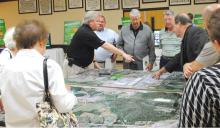Understanding the cultural background, history, location, primary language, values, accessibility needs, etc. of your community’s various “audiences” is key to designing an effective communications strategy for any crisis or emergency situation.49 To maximize lifesaving and minimize community disruption following a chemical release, each individual audience’s needs must be met during advance message preparation and approval. In-the-moment, there may not be enough time to translate, simplify, or rephrase a message. Therefore, the characteristics of the whole community – across all population segments (audiences) – should be defined before a chemical incident public messaging campaign is developed. Tools such as community-wide surveys can be used to:
- Review population data
- Identify locations to focus pre-planning efforts
- Gain insight into the needs and concerns of specific populations
- Identify populations that may benefit from different or more specific instructions, including individuals with disabilities and those that support them
- Determine whether additional outreach efforts may be required to reach certain groups
- Collect actionable planning data related to information access and availability during catastrophic incidents
- Identify businesses, neighborhoods, or groups with existing emergency communication plans
- Identify common sources of information/preferred methods of communication for the population
These surveys should identify non-traditional community groups that live, work, and gather in the community, such as farmers, the homeless, workers from other towns, people shopping, tourists, and people commuting to schools. In addition, the surveys should strive to reach traditionally undervalued, underrepresented, and underserved (U3) populations including elderly, disabled, non-documented, and homeless populations, racial and ethnic minorities, people with limited English proficiency, those impacted by the digital divide, LGBTQI+ communities, etc.
Information collected from such a survey will help public communications staff develop successful whole-community messaging campaigns. Such campaigns can be expected to include a variety of messaging types for use during a chemical incident to ensure that all persons have equal access to the information. For example, schools will need more focused messaging than the general population, and large groups of people with limited English proficiency will need messages translated into their native language(s). Audiences such as parents of schoolchildren and people with disabilities, limited mobility, and others may have questions about protective action directives that the general public does not. Farmers may require specific instruction about how to best protect their livestock, or what they may need to do with their crops. In addition, discussing the specific considerations needed by different groups with first responders (police, fire, EMS, etc.) will help them understand the different audiences within the community and any additional instructions they might receive before or while responding.
Thinking more broadly, a list of anticipated public questions from wider audiences can be formulated; these should address the concerns of both affected and non-affected localities as well as the regional, national, and international community.

Community surveys are also a good place to start building public trust in chemical incident planning efforts. Initially, many people and organizations (businesses, schools, etc.) will be frightened by being asked to consider the possibility of a chemical release scenario happening. Surveys that explain why they should plan for a chemical incident will go far toward gaining their trust. Existing emergency plans can be shared among similar facilities and used as a starting point for chemical incident-specific planning. These discussions present an opportunity for preparedness outreach and trust building within the community as organizations work together to plan for local risk scenarios.
6.1.1 Communicating With Underserved Communities
Recall that underserved populations, including populations of color, have faced disparate, historic and ongoing burdens and impacts from industrial chemicals, chemical facilities, chemical waste disposal, and chemical disasters. As a result, the responses of such populations to information regarding new incidents may differ from those of the larger affected community. Addressing the special concerns of these populations may require non-conventional messaging strategies, vehicles, and messaging. With this knowledge, and pursuant to the 2021 Executive Order On Advancing Racial Equity and Support for Underserved Communities Through the Federal Government (EO 19385), the authors understand that these communities are less likely to have access to the resources or expertise needed to support such non-conventional approaches. As federal and SLTT agencies work to address past inequities, the development of capabilities for chemical incident communications that adequately serve all communities is hoped for and expected.
Footnotes
49. U.S. Department of Health and Human Services. (2006). Terrorism and Other Public Health Emergencies: A Field Guide for Media.


